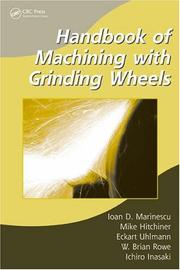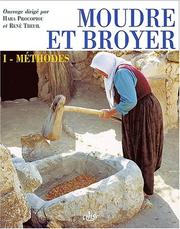| Listing 1 - 8 of 8 |
Sort by
|
Book
Year: 1927 Publisher: [Washington, D.C.] : [U.S. Government Printing Office],
Abstract | Keywords | Export | Availability | Bookmark
 Loading...
Loading...Choose an application
- Reference Manager
- EndNote
- RefWorks (Direct export to RefWorks)
Grinding wheels. --- Industrial accidents. --- Industrial safety.

ISBN: 9781574446715 Year: 2007 Publisher: Boca Raton CRC
Abstract | Keywords | Export | Availability | Bookmark
 Loading...
Loading...Choose an application
- Reference Manager
- EndNote
- RefWorks (Direct export to RefWorks)
Grinding and polishing --- Grinding wheels --- Machine-tools
Book
ISBN: 0878494162 Year: 2007 Publisher: Zürich Trans tech publ.
Abstract | Keywords | Export | Availability | Bookmark
 Loading...
Loading...Choose an application
- Reference Manager
- EndNote
- RefWorks (Direct export to RefWorks)
Book
Year: 1971 Volume: 15 Publisher: Luanda : Instituto de Investigação Científica de Angola,
Abstract | Keywords | Export | Availability | Bookmark
 Loading...
Loading...Choose an application
- Reference Manager
- EndNote
- RefWorks (Direct export to RefWorks)
Grinding wheels --- Meules --- Angola --- Angola --- Antiquities --- Antiquités
Book
ISBN: 9630515768 Year: 1980 Publisher: Budapest : Akadémiai Kiadó,
Abstract | Keywords | Export | Availability | Bookmark
 Loading...
Loading...Choose an application
- Reference Manager
- EndNote
- RefWorks (Direct export to RefWorks)
621.921 --- Grinding wheels --- Abrasives --- Ceramic materials --- Ceramic industries --- Ceramics --- Mines and mineral resources --- Abrasive wheels --- Grindstones --- Grinding and polishing --- Grinding machines --- Abrasives. Grinding materials. Polishing materials --- Materials --- Abrasives. --- Ceramic materials. --- Grinding wheels. --- 621.921 Abrasives. Grinding materials. Polishing materials --- Ceramics. --- Binders --- Grinding (size reduction)
Book
ISBN: 285400048X Year: 1985 Publisher: Senlis : CETIM,
Abstract | Keywords | Export | Availability | Bookmark
 Loading...
Loading...Choose an application
- Reference Manager
- EndNote
- RefWorks (Direct export to RefWorks)
621.92 --- Abrasive materials and tools. Grinding and allied techniques. Crushing, separating, mixing of abrasives --- Machining --- Metals --- Grinding wheels --- Usinage --- Métaux --- Meules (outils) --- Finishing --- Finition --- 621.92 Abrasive materials and tools. Grinding and allied techniques. Crushing, separating, mixing of abrasives --- Usinage. --- Finition.


ISBN: 2735505022 2735505057 9782735505029 9782735505050 Year: 2002 Volume: 3 Publisher: [Paris] : CTHS,
Abstract | Keywords | Export | Availability | Bookmark
 Loading...
Loading...Choose an application
- Reference Manager
- EndNote
- RefWorks (Direct export to RefWorks)
La farine moulue aux meules est aujourd’hui un argument de vente efficace des pains dits traditionnels. Les outils et les techniques de broyage et de mouture ont donc toujours joué un rôle important dans la préparation de la nourriture.Mais on s'aperçoit de plus en plus qu'ils ont servi à bien d'autres usages et que leur histoire est riche et complexe. Certains animaux savent déjà concasser des noix. L'homme, lui, n'a jamais cessé de perfectionner ses outils et de les adapter à de nouveaux usages. Chaque époque a donc « ses » meules, qui reflètent son niveau technique, ses capacités d'emprunt ou d'innovation et ses conditions socio-économiques. Les méthodes scientifiques modernes révèlent en outre, par-delà la simplicité des outils, la diversité des matières (colorants, minerais…) qui ont pu être traitées et la variété parfois insoupçonnée des produits qui en ont été tirés.Elles nous font enfin pénétrer – et c'est le plus inattendu – dans l'organisation de chaque société : ce sont d'abord les femmes qui actionnent les meules à va-et-vient, souvent en s'aidant de chants rythmiques; mais les meules rotatives, qui permettent une productivité accrue et un changement d'échelle, sont prises en charge par des hommes…Diverses voies d'approche sont illustrées dans ce volume 1 : études pétrographiques sur les roches utilisées, examen des traces d'utilisation et analyses de résidus, approche expérimentale, démarches ethnologique et ethnoarchéologique.
Tools, Prehistoric --- Agricultural implements, Prehistoric --- Grinding wheels --- Archaeology --- Outils préhistoriques --- Outils agricoles préhistoriques --- Meules --- Archéologie --- Congresses --- History --- Methodology --- Congresses. --- Congrès --- Histoire --- Méthodologie --- Mortars --- Size reduction of materials --- Comminution --- Grinding (Size reduction) --- Particle size reduction --- Mills and mill-work --- Implements, utensils, etc. --- Meules (outils) --- Archéologie --- Outils préhistoriques. --- Ethnoarchéologie. --- Agriculture préhistorique. --- Méthodologie.
Book
ISBN: 3038429376 3038429384 Year: 2019 Publisher: MDPI - Multidisciplinary Digital Publishing Institute
Abstract | Keywords | Export | Availability | Bookmark
 Loading...
Loading...Choose an application
- Reference Manager
- EndNote
- RefWorks (Direct export to RefWorks)
This specialist edition features key innovations in the science and engineering of new grinding processes, abrasives, tools, machines, and systems for a range of important industrial applications. Topics written by invited, internationally recognized authors review the advances and present results of research over a range of well-known grinding processes. A significant introductory review chapter explores innovations to achieve high productivity and very high precision in grinding. The reviewed applications range from grinding systems for very large lenses and reflectors, through to medium size grinding machine processes, and down to grinding very small components used in MEMS . Early research chapters explore the influence of grinding wheel topography on surface integrity and wheel wear. A novel chapter on abrasive processes also addresses the finishing of parts produced by additive manufacturing through mass finishing. Materials to be ground range from conventional engineering steels to aerospace materials, ceramics, and composites. The research findings highlight important new results for avoiding material sub-surface damage. The papers compiled in this book include references to many source publications which will be found invaluable for further research, such as new features introduced into control systems to improve process efficiency. The papers also reflect significant improvements and research findings relating to many aspects of grinding processes, including machines, materials, abrasives, wheel preparation, coolants, lubricants, and fluid delivery. Finally, a definitive chapter summarizes the optimal settings for high precision and the achievement of centerless grinding stability.
wheels --- safe operation --- precision --- lubrication --- surface roughness --- microgrinding --- high-performance dry grinding --- micro-grinding --- brittle hard materials --- glass --- micropencil grinding tools --- topography --- glass–ceramic --- cutting edge --- coolant delivery --- quality --- fusion --- materials --- metal additive manufacturing --- profile gear grinding --- grinding fluid --- coolant --- contact conditions --- metal cutting fluid --- grinding --- self-sharpening --- mass finishing --- process optimization --- centerless grinding --- grinding fluid nozzle --- laser --- productivity --- systems --- subsurface damages --- NC-form grinding --- sodium dodecyl sulfate --- grinding wheels --- processes --- jet breakup --- control --- removal rates --- wear modelling --- precision grinding --- optics manufacturing --- sensors --- bonding --- microstructures --- machines --- thermo-mechanical stress collective
| Listing 1 - 8 of 8 |
Sort by
|

 Search
Search Feedback
Feedback About UniCat
About UniCat  Help
Help News
News